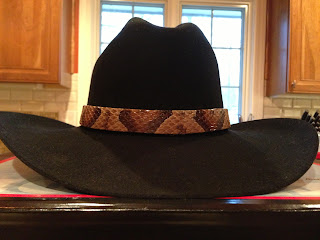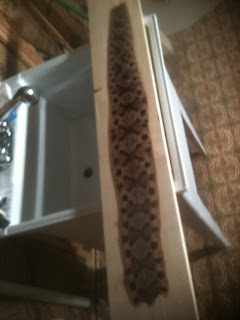Fill a gallon jug two-thirds full of water. Dissolve as much plain salt (non-iodized) in the water as possible. Stir the water as you add the salt and when you see the crystals sinking to the bottom instead of dissolving, that is enough salt. (It will take about 2 lbs of salt to a gallon of water)
Place the skin in loose fold (not rolled) in the salt water solution.
Seal the jug, and leave a room temperature (70 degrees) for four days. Rotate the jug gently once or twice a day.
Remove from he salt water on the fourth day. Rinse for several minutes and lightly pat dry on towels.
Mix a solution of equal parts glycerin and water. Pure glycerin is available at most drugstores.
Two pints of glycerin mixed with water is sufficient to treat three medium-sized snake skins.
Place the skin in the glycerin solution, cover and let stand at room temperature for another four days. Rotate but do not shake the jug daily.
After the skin has been in the glycerin solution four days, remove and pat dry with a towel.
Place the dry skin on an unfinished, dry, flat pine board. The boards must be long and wide enough to sandwich the whole skin. Do not stretch the skin to flatten it, just roll it out smoothly on the board. Use the flat of your hand to remove and wrinkles.
Place a second pine board on top of the skin. The skin must be firmly pressed, so weigh down the top board.
Let dry for four days. It may take a little longer in the dead of winter or in humid conditions.
When the skin is dry, it will be soft and pliable. Put a little talcum powder on the dry hide and roll it around on an old paper-towel roll ( one of those cardboard rollers) and it will keep until you are ready to turn it into a hatband or mount it on a display board.
I of course decided to make a hat band. I went to a local Tandy Leather Store where I explained to the proprietor what I was trying to accomplish, that I need some strips of suitable leather and Rubber contact cement. He helped me find a bottle of the cement which is used for just such purposes. He then gave me some scraps of leather. He even cut several pieces to width for me.
When I arrived back at the Hacienda, I found that I had more than enough snake skin to make two hat bands, so that is what I decided to do.
Using a razor knife I cut the skin lengthwise down the middle so that I had two pieces approximately the same length and width. I then turned them over and using one of the leather backing strips as a guide, I applied the contact cement liberally in the approximate center of the skins. I then applied contact cement to each of the outside (smooth side) of leather strips. Once this was completed I had to allow them to "set up" before I could join the skins and leather backing.
 | |||
| Applying rubber cement to the leather backing |
 |
| Applying cement prior to folding the skin over the back of the leather backing strip |
 | ||||
| Ready to fold skin over leather backing to finish the 2nd Band trimmed off excess length |
I then cut the skin so that there was about 1/2" beyond each end of the leather backing and I made it square. I then carefully folded the ends over, and pleated the sides and folded them over also.
 |
| The two pieces of snake skin completely joined to the leather backing (view 1) |
 |
| The two pieces of snake skin completely joined to the leather backing (view 2) |
Once the skins and leather had been joined I needed to decide how I would join the ends. I decided to use Leather Boot Laces. I then used a leather punch to punch two holes in each end of the two hatbands. I then threaded the laces through them as you would if you were lacing shoes.
 |
| Back of Hatband after lacing |
 |
| Front of Hatband 1 |
 |
| Front of Hatband 2 |
 |
| Top view of the Hatbands on the pine board used to cure the skin |
 |
| Inside of a hatband, you can see the different type of belly scales on this one |
I gave him the hatband on a trip to his homestead in the great northwest. I described to him how I was thinking of braiding the tails of the laces on my hatband and putting silver beads in the shape of skulls in the braid. MBB also has a crafty streak in him (in more ways than one). He has made on occasion, very nice zipper pulls he creates out of braided wire, semi-precious stones, silver, pewter and other metals. He whipped out his collection of items he had for the fabrication of the pulls and found several solid silver miniature facsimiles of a Celtic Battle Axe Heads. He gave me one for my hatband and promptly figured a way to attach one to his.
I now had one last item to take care of in order to finish this project. I needed a Cowboy hat. Not just any hat would do, it would have to be either a Resistol or a Stetson. I had the maker somewhat narrowed down, so the final choice would have to be based on style. I had already decided on Black... Yes, I know, in the parlance of my childhood, good guys only wore white or light colored hats.. Except for Paladin of course. I decided that the snakeskin would stand out better against a black background.
It took me a while, but I finally settled on a hat style, I liked the hat that Timothy Oliphant wears as the character US Deputy Marshall, Raylan Givens in Justified. The hat is a Stetson Carson model. Raylan's hat is "Silver Belly", mine would still be black. I went to a local Western Wear shop, determined my size, and ordered a hat.
 |
| Black Stetson Carson hat (by the way, this photo was taken in the same general area as the earlier photos of the hatband creation, I finished the kitchen) |
 |
| Front view of the hat, the black really makes the Copperhead pattern pop. |
 |
| Side view of the hat, from this view you can see how the hatband stands out, and the sweep of the brim |
 |
| Close up of the Skull Beads |
 |
| A Skull bead and the Silver Celtic Battle Axe |
 |
| The Front Center of the hatband. |




No comments:
Post a Comment